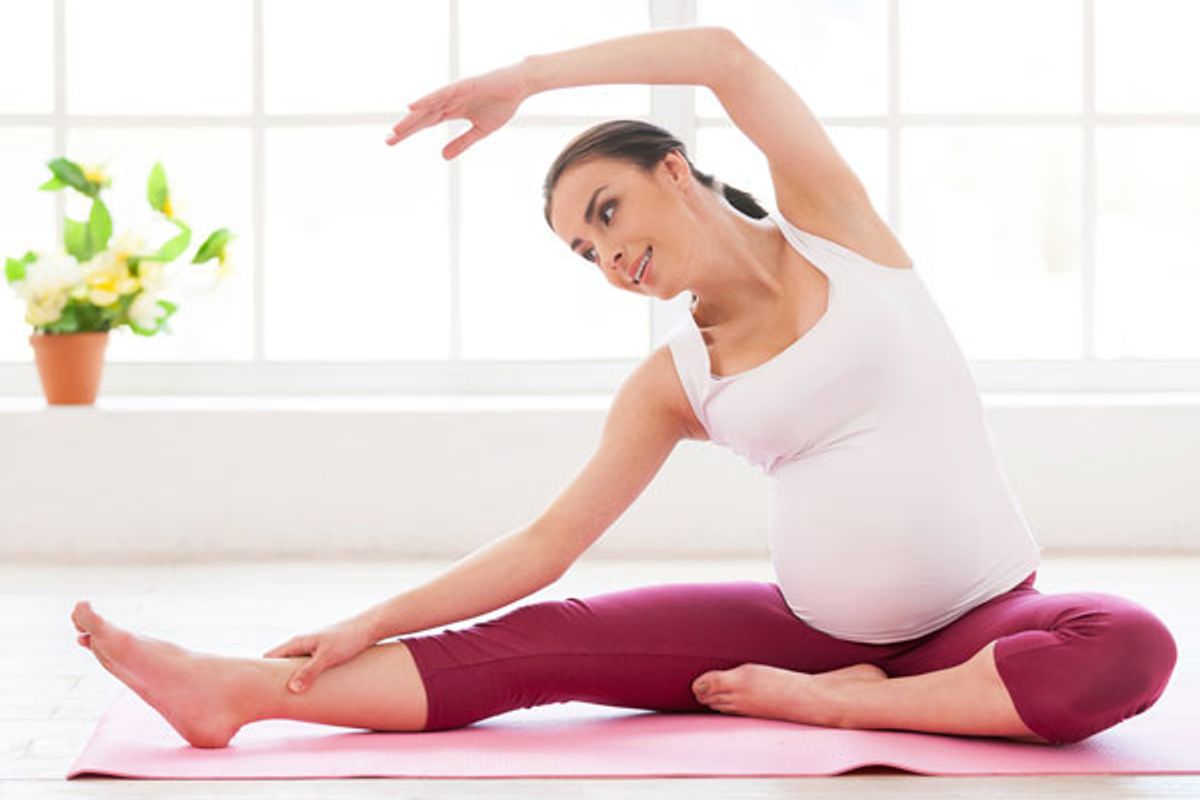by Stephanie F. Deivert, RD, LDN
Exercise and taking care of yourself become much more important during pregnancy, because now it is not just YOU anymore.
So you're pregnant, you're gaining weight, you feel tired and certainly not your best. With all of this, how and why exercise?
The little one growing inside of you is relying on you to take the best care of yourself and provide the healthiest environment for them to develop. Regular exercise builds bones and muscles and gives you more energy and endurance.
When you are pregnant, you may be plagued with backaches, constipation, swelling and bloating, all of which exercise helps. It can help prevent dangerous excessive weight gain during pregnancy, as well as gestational diabetes. If nothing else, it makes you feel like you can get through the day, improving your mood and helping you sleep better.
Things to Consider When Exercising While Pregnant
Some things to take into consideration about your body while you are pregnant when considering exercise are:
- Your balance: During pregnancy you may be carrying an extra 15 to 40 pounds (gained in a relatively short time and usually mainly in your front); this can make you less stable and more likely to lose your balance, especially later in pregnancy.
- Your joints: Hormones produced during pregnancy cause stretching of ligaments that support your joints, which could put you at a higher risk for injury.
- Your heart rate and rate of breathing: The further along you are in your pregnancy, the harder your body will need to work just to carry your extra weight. You will notice an increase in your heart rate and rate of breathing, even doing simple tasks. Exercise increases the rate of oxygen delivery to the muscles you are working out and away from other parts of your body (your baby). So, it is important not to overdo it.
Tips for Safety:
- Before exercise, talk to your health care provider about your exercise plans. Your health care provider will be able to give you individualized recommendations based on your medical history.
- Exercise at a pace where you can talk comfortably, never to the point of breathlessness or exhaustion.
- Try not to let your heart rate go above 140 beats per minute.
- Avoid bouncy, high impact or jerky motions.
- Listen to your body. Take frequent breaks and drink plenty of fluids.
- Avoid exercise in extremely hot or cold weather.
- Wear comfortable footwear with strong ankle and arch support.
- Avoid rocky terrain and slippery or unstable ground.
- Avoid contact sports or sports that may cause trauma (skiing, horseback riding) while pregnant.
- Avoid standing still for long periods.
- During the second and third trimesters, avoid exercises that involve lying flat on your back; this decreases blood flow to your womb.
- Include warm-up and cool downs, including stretching with your workouts. Aim for about 10 to 15 minutes for each warm-up and cool down.
Choosing what type of exercise you do depends on your baseline level of activity. Most types of exercise are safe during pregnancy. If you have not exercised regularly before becoming pregnant, you can still start a regular routine—just start slowly. Try starting with five minutes of exercise every day, then try adding five minutes every week until you are up to 30 minutes per day on most days of the week.
Exercise Ideas for Everyone
Walking: Brisk walking gives your total body a workout and is easy on your muscles and joints. Walking is considered a safe form of exercise to start during pregnancy.
Swimming: Swimming works out your body and uses the water as resistance for toning up your muscles. It prevents swelling (which can happen with walking or other upright exercises), and it also helps you stay cool in warm weather.
Aerobics or Pilates: Some classes and videos are designed especially for pregnant women. You may want to consider water aerobics or low-impact aerobics.
Cycling: Ideally use stationary or recumbent positions with your growing belly and precious cargo. You will get an excellent aerobic and strength workout with cycling.
Yoga: Look for prenatal yoga videos and classes. The stretching, strength and breathing exercises help prepare you for giving birth and teach you to calm and center yourself.
Ball exercises: These exercises will help you build your core strength. You will need a stability ball (55-75 cm depending on height). You can start during your first trimester and do them as many days as you would like. Even just balancing and sitting on the stability ball will help build core strength.
Dancing: Some forms of dancing could be a safe and fun way to get exercise during early pregnancy. Some women take salsa or jazz dance lessons. However, as your belly grows, you want to be cautious about your increasing lack of balance and also want to avoid jerky and bouncy movements.
Exercise Routines Continued From Before Pregnancy
If you exercised regularly before becoming pregnant, most health care professionals will tell you it is OK to continue with that form of exercise during pregnancy. You just need to listen to your body and modify your routine as necessary. Remember, if you feel like you are not getting enough oxygen, your baby is feeling the same way.
Running: If you were a runner before you became pregnant, it is OK to continue running. Elliptical or ski trainers are also great ways to get a cardio and strength workout.
Strength training: This helps increase your muscle tone and may even help decrease or prevent some aches and pains that are common during pregnancy. Remember, during pregnancy it is a good idea to use less weight and do more repetitions.
Exercises to Help Prepare for Labor
Start these exercise early in your third trimester to help strengthen your muscles for delivery.
Kegel exercises: These exercises strengthen the pelvic floor. You should do these daily, multiple times per day, to help prevent urinary incontinence, decrease risk of hemorrhoids and speed the healing after an episiotomy or tear, should you have one during childbirth. Some evidence suggests that a strong pelvic floor may shorten the pushing stage of labor. Repeatedly contract (for a count of four) and then relax your pelvic-floor muscles as though you're stopping and starting the flow of urine. DO NOT actually do it while you are urinating.
Pelvic tilts: This variation of the pelvic tilt, done on all fours, strengthens the abdominal muscles and eases back pain during pregnancy and labor. Get down on your hands and knees and as you breathe in, tighten your abdominal muscles and tuck your buttocks under and round your back (like a cat arching its back). Relax your back into a neutral position as you breathe out.
Squats: Squatting helps to prepare for giving birth. This exercise strengthens your thighs and helps open your pelvis. Stand with your feet slightly more than hip-width apart, toes pointed outward (you could hold something for balance). Contract your abdominal muscles, lift your chest and relax your shoulders. Then lower your tailbone toward the floor as though you were sitting down on a chair. Take a deep breath in and then exhale, pushing into your legs to rise to a standing position.
Tailor pose: This position can help open your pelvis and loosen your hip joints in preparation for birth. It can also improve your posture and ease tension in your lower back. Sit up straight against a wall with the soles of your feet touching each other (sit on a folded towel or chair cushion if that's more comfortable for you). Gently press your knees down and away from each other, but do not force them. Stay in this position for as long as you're comfortable. You can even sit watching TV this way.
Exercise Because It's Important
Whether you were inactive or a marathon runner before pregnancy, light to moderate exercise during pregnancy is important and helpful to keep you and your baby healthy and to build stamina for labor and delivery. Just remember not to overdo it, listen to your body and pick something that is fun and relaxing for you and your baby.
Stephanie F. Deivert, RD, LDN, has been with the Center for Nutrition and Weight Management at Geisinger Health System since 2002. She completed her Bachelor's in Nutritional Sciences and Exercise Physiology at Penn State University in 2002 and her Dietetic Internship at Geisinger Medical Center in 2004.







